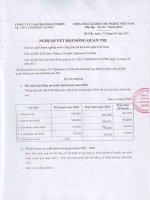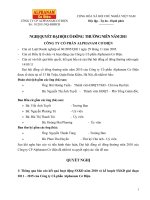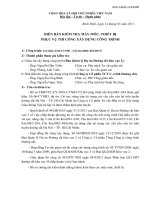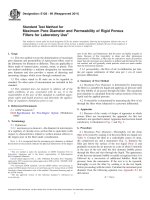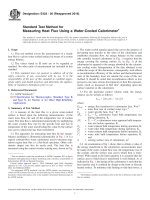E 575 05 (2011)
Bạn đang xem bản rút gọn của tài liệu. Xem và tải ngay bản đầy đủ của tài liệu tại đây (56.86 KB, 3 trang )
Designation: E575 − 05 (Reapproved 2011)
Standard Practice for
Reporting Data from Structural Tests of Building
Constructions, Elements, Connections, and Assemblies1
This standard is issued under the fixed designation E575; the number immediately following the designation indicates the year of
original adoption or, in the case of revision, the year of last revision. A number in parentheses indicates the year of last reapproval. A
superscript epsilon (´) indicates an editorial change since the last revision or reapproval.
1. Scope
5. Organization of Report
1.1 This practice covers general use in reporting structural
performance tests of building constructions, elements,
connections, and assemblies. A comprehensive report describing the conditions under which the structural data were
recorded will enable other workers to reproduce the test
methods and, as nearly as possible, the results for each material
or assembly, and to reconcile differences that might be found in
tests by others.
5.1 Generally, a report shall contain the following parts in
the sequence listed:
5.1.1 Title page with byline,
5.1.2 Object statement,
5.1.3 Descriptions of specimen(s) and apparatus,
5.1.4 Procedure statement,
5.1.5 Discussion of test results,
5.1.6 Conclusion,
5.1.7 Recommendations,
5.1.8 References,
5.1.9 Pictures,
5.1.10 Tabulations,
5.1.11 Calculations, and
5.1.12 Supplementary data.
1.2 This standard does not purport to address all of the
safety concerns, if any, associated with its use. It is the
responsibility of the user of this standard to establish appropriate safety and health practices and determine the applicability of regulatory limitations prior to use.
5.2 Use the headings listed that are appropriate. Use other
more appropriate headings if they better describe the content.
2. Referenced Documents
2.1 ASTM Standards:2
E631 Terminology of Building Constructions
5.3 When the expected readership includes both experts and
laymen, an early insertion in nontechnical language of the
necessary background, data summary, and results is useful.
3. Terminology
6. Documented Information
3.1 For definitions of terms used in this practice, see
Terminology E631.
6.1 A report shall include the following information, but not
necessarily in the order listed:
6.1.1 Title—A title shall be brief but definitive.
6.1.2 Author—One first name and surname and any professional registration shall be included in a byline for positive
identification.
6.1.3 Date of test and date of report.
6.1.4 Test agency, sponsor, and their mailing addresses.
6.1.5 Specimen Selection and Identification—Indicate the
number of specimens, method of choosing them, and whether
they were specially fabricated for this test, prototypes of
planned production, randomly selected production units, and so
forth. If specimens were obtained from routine production,
include the manufacturer’s name, source of supply, specimen
dimensions, model, type, materials, and other pertinent information such as quality, conditioning, and treatment, including
data on assembly techniques and fastenings.
6.1.6 Specimen Drawings—Drawings shall provide a description of the physical characteristics and dimensioned section profiles and any other pertinent construction details. This
4. Significance and Use
4.1 This practice provides a standard procedure for reporting data and results of structural tests used for building
constructions, elements, corrections, and assemblies. It enumerates and discusses the report sections required to report
data from test methods and practices. The written reports will
describe the products tested, method of testing, and results.
1
This practice is under the jurisdiction of ASTM Committee E06 on Performance of Buildings and is the direct responsibility of Subcommittee E06.11 on
Horizontal and Vertical Structures/Structural Performance of Completed Structures.
Current edition approved April 1, 2011. Published May 2011. Originally
approved in 1976. Last previous edition approved in 1999 as E575 – 99. DOI:
10.1520/E0575-05.
2
For referenced ASTM standards, visit the ASTM website, www.astm.org, or
contact ASTM Customer Service at For Annual Book of ASTM
Standards volume information, refer to the standard’s Document Summary page on
the ASTM website.
Copyright © ASTM International, 100 Barr Harbor Drive, PO Box C700, West Conshohocken, PA 19428-2959. United States
1
E575 − 05 (Reapproved 2011)
requirement may be waived if an existing description is easily
available and is included by reference. Any modification made
to the specimen to obtain a measurement or reading shall be
noted. Any unusual characteristics or conditions existing in the
specimen construction prior to test shall be described.
6.1.7 Specimen Design—Details shall be provided for an
understanding of the principles used in the structural design of
the specimen.
6.1.8 Apparatus Description—Sufficient details shall be
provided to explain the construction, operation, and position of
the test apparatus. This description may require a presentation
of the structural design of the apparatus, especially if it is
original in design or operation. This requirement may be
waived if an existing description is easily available and is
included by reference.
6.1.9 Specimen Installation—Illustrations and a description
of details of installation in or attachment to the test apparatus
shall be provided for each type of specimen. Details of restraint
devices and their location relative to the specimen shall be
described as well as the locations of loading and reaction
points.
6.1.10 Instrumentation—A report shall describe the
location, direction of measurement, and technical specifications of any instrumentation used to measure loads, reactions,
and deformations generated by the test apparatus and the
specimen. A description of the working condition, tolerances,
and accuracy of such meters is useful. The relative deformation
measured by each gage shall be described.
6.1.11 Ambient Conditions—Records of temperature, relative humidity, moisture content, seasoning, and any other
conditions that are relevant to structural performance of the
specimen shall be included. A history of such conditions from
the time of construction until the time of test may be more
significant than those present at the time of test, and therefore,
if warranted, measurements of ambient conditions and the
condition of the specimen from the time of specimen construction shall be made.
6.1.12 Specimen Weight—A report shall state the amount of
dead load of the apparatus or specimen that has been deducted
if the net load or strength is reported or that may be deducted
if the gross load or strength is reported.
6.1.13 Load-Deformation Graphs—Graphs portraying the
specimen’s response to loading shall be included for each
deformation-measuring device.
6.1.14 Failure Load and Description—Specimens can have
more than one failure mode, for example, ductile or brittle
fracture, yielding, excessive deflection, or harmful distortion.
Applicable modes of failure shall be described in general terms
with criteria for their measurement. A description of each
specimen’s failure mode and a value of its ultimate strength or
maximum load or both shall be tabulated.
6.1.15 Time Under Load—A load-time record is needed to
interpret some test results and shall be presented as a graph or
tabulation to indicate the time duration for each magnitude of
load.
6.1.16 Photographs—Photographs of the specimen before
and after testing shall be provided to show what cannot be
described easily or clearly by writing. However, if the mode of
failure is well known, the photographs are optional.
6.1.17 Video (optional)—A video may be used as a standard
practice for reporting data from structural tests of building
constructions, elements, connections, and assemblies. The
video may be used in conjunction with a written test report.
Generally, a video should contain the following parts:
6.1.17.1 Object statement (title and author),
6.1.17.2 Specimen design and selection,
6.1.17.3 Apparatus description,
6.1.17.4 Specimen installation,
6.1.17.5 Instrumentation,
6.1.17.6 Ambient conditions,
6.1.17.7 Specimen weight (dead and live),
6.1.17.8 Testing,
6.1.17.9 Failure load and description,
6.1.17.10 Time under load,
6.1.17.11 Conformity of specimen,
6.1.17.12 Officials (technicians, professionals, and
observers), and
6.1.17.13 Appendixes.
6.1.18 Use the headings listed that are appropriate. Use
other more appropriate headings may be used, if they better
describe the contents.
7. Conformity
7.1 A report shall contain a statement indicating whether or
not the construction of the test specimen represents actual or
intended construction. If the construction does not represent
typical manufacture, deviations shall be noted.
7.2 When a standard test method is used, a statement shall
be included indicating its name and designation. Deviations
from it shall be described.
8. Officials
8.1 Signatures of persons responsible for the supervision of
a test shall be included as well as a list of any official observers.
9. Appendixes
9.1 All data not specifically required by a testing standard
but useful to a better understanding of the test results,
conclusions, or recommendations should be appended to a
report.
10. Keywords
10.1 building construction; structural tests
2
E575 − 05 (Reapproved 2011)
ASTM International takes no position respecting the validity of any patent rights asserted in connection with any item mentioned
in this standard. Users of this standard are expressly advised that determination of the validity of any such patent rights, and the risk
of infringement of such rights, are entirely their own responsibility.
This standard is subject to revision at any time by the responsible technical committee and must be reviewed every five years and
if not revised, either reapproved or withdrawn. Your comments are invited either for revision of this standard or for additional standards
and should be addressed to ASTM International Headquarters. Your comments will receive careful consideration at a meeting of the
responsible technical committee, which you may attend. If you feel that your comments have not received a fair hearing you should
make your views known to the ASTM Committee on Standards, at the address shown below.
This standard is copyrighted by ASTM International, 100 Barr Harbor Drive, PO Box C700, West Conshohocken, PA 19428-2959,
United States. Individual reprints (single or multiple copies) of this standard may be obtained by contacting ASTM at the above
address or at 610-832-9585 (phone), 610-832-9555 (fax), or (e-mail); or through the ASTM website
(www.astm.org). Permission rights to photocopy the standard may also be secured from the ASTM website (www.astm.org/
COPYRIGHT/).
3
